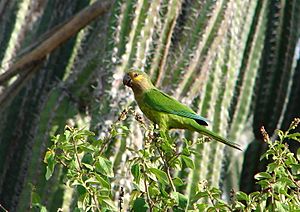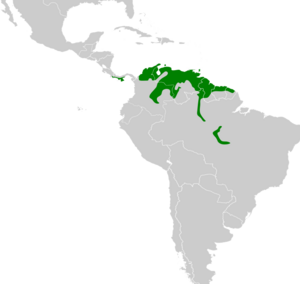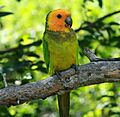Brown-throated parakeet facts for kids
Quick facts for kids Brown-throated parakeet |
|
|---|---|
 |
|
| A brown-throated parakeet (subspecies E. p. arubensis) in Aruba | |
| Conservation status | |
| Scientific classification | |
| Genus: |
Eupsittula
|
| Species: |
pertinax
|
 |
|
The brown-throated parakeet (Eupsittula pertinax) is a type of parrot. People sometimes call it the St. Thomas conure or brown-throated conure. This bird lives in Costa Rica, Panama, the northern parts of South America, and islands near the coast.
Contents
About the Brown-throated Parakeet
How Scientists Name Them
The brown-throated parakeet was first officially described in 1758. This was done by a Swedish scientist named Carl Linnaeus. He gave it the scientific name Psittacus pertinax.
Today, this parakeet is part of the Eupsittula group. This group was named in 1853 by a French scientist, Charles Lucien Bonaparte. The name Eupsittula means "good little parrot" in Ancient Greek and Neo-Latin. The word pertinax comes from Latin and means "tenacious" or "persistent."
Different Types of Brown-throated Parakeets
There are 14 different kinds, or subspecies, of the brown-throated parakeet. Some of these live only on certain islands. Here are some of them:
- E. p. ocularis
- E. p. aeruginosa
- E. p. griseipecta
- E. p. lehmanni
- E. p. arubensis
- E. p. pertinax
- E. p. xanthogenia
- E. p. tortugensis
- E. p. margaritensis
- E. p. venezuelae
- E. p. surinama
- E. p. chrysophrys
- E. p. chrysogenys
- E. p. paraensis
Sometimes, E. p. ocularis is thought of as its own separate species. It is called the "Veraguas parakeet."
What They Look Like
The brown-throated parakeet is about 23 to 28 centimeters (9 to 11 inches) long. It weighs between 76 and 102 grams (2.7 to 3.6 ounces). Male and female parakeets look the same.
The most common type, E. p. pertinax, has a yellow forehead, face, and chin. Its head, neck, and upper body are green. Its chest is a dull olive color, and its belly is grass green. It has an orange spot in the middle of its belly. Their wings are mostly green with blue edges. Their tail feathers are also green with blue tips. Young birds have very little yellow.
Other subspecies have slightly different colors:
- E. p. ocularis has an olive-brown face.
- E. p. arubensis has a yellow face with some brown.
- E. p. chrysogenys is darker than most others.
- E. p. paraensis is also dark and has an orange-yellow belly.
Where They Live
Brown-throated parakeets live in many different places. These include savannas, dry scrublands, and forests. They also live in areas where people grow crops. In Colombia, they can be found high up in the mountains. In other places, they usually live below 1,200 meters (3,900 feet).
Specific Locations for Each Subspecies
Each subspecies lives in certain areas:
- E. p. ocularis lives in southwestern Costa Rica and Panama.
- E. p. aeruginosa is found in northern Colombia and northwestern Venezuela.
- E. p. arubensis lives on the island of Aruba.
- E. p. pertinax lives on Curaçao.
- E. p. xanthogenia is found on Bonaire.
- E. p. tortugensis lives on La Tortuga Island near Venezuela.
- E. p. margaritensis lives on Margarita Island near Venezuela.
- E. p. venezuelae lives in northern and central Venezuela.
- E. p. surinama is found from northeastern Venezuela through the Guianas.
- E. p. chrysophrys lives in southeastern Venezuela and northern Brazil.
- E. p. chrysogenys lives in northwestern Brazil.
- E. p. paraensis lives in north-central Brazil.
Introduced Populations
The E. p. pertinax subspecies was brought to Saint Thomas, U.S. Virgin Islands in the 1860s. From there, it spread to other islands like Culebra Island and Tortola. However, they disappeared from these islands by 1982. Some sightings in Puerto Rico and Florida are likely from pet birds that escaped.
The species also visits Trinidad but does not breed there.
How They Behave
Moving Around
Some groups of these parakeets move from place to place during different seasons. They also travel to find food.
What They Eat
Brown-throated parakeets eat many things. Their diet includes seeds, fruits, nuts, flowers, and leaves. Sometimes, they even eat insects. In Venezuela, a lot of their food comes from plants grown by people.
They can be a problem for farmers because they eat crops like corn. They also eat fruit from plantations. These parakeets often look for food in pairs or small groups. When flying, they call out. If other parakeets hear them and are eating, they might join the group.
How They Breed
The time when brown-throated parakeets nest changes depending on where they live. In Suriname and the Antilles, they might nest almost any time of year. In Colombia and Venezuela, they nest from February to April.
They usually dig a hole in a termite nest in a tree. They also nest in natural holes in trees, cliffs, or dirt banks. Sometimes, several pairs will nest together in one old, rotten tree. A female parakeet lays two to seven eggs. The eggs hatch after about 23 days. The young birds are ready to fly after 36 to 37 days.
Their Calls
Brown-throated parakeets are very noisy birds. When they fly, they make loud, high-pitched screeches. They also make harsh, grating "scraart scraart" sounds. From a perch, they make shorter "tchrit tchrit" calls and chattering noises.
The calls of parakeets living on islands can be different from those on the mainland. This might be because of windy island environments. It could also be due to the isolation of these island groups.
Their Status
The IUCN (International Union for Conservation of Nature) says the brown-throated parakeet is a species of "Least Concern." This means they are not currently in danger of disappearing. They live in a very large area, and there are at least five million adult birds. Their population seems to be stable.
No big threats have been found for them. They are the most common parrot in many parts of their range. However, the E. p. tortugensis subspecies seems to be decreasing. Also, in mainland Venezuela, people sometimes harm them because they eat crops.
People sometimes take young birds from nests on islands to sell as pets. In Venezuela, both young and adult birds are sold locally. However, they are not traded very often in the global pet market compared to other parrots.
Images for kids
-
E. p. xanthogenia on the island of Bonaire, Netherlands Antilles







